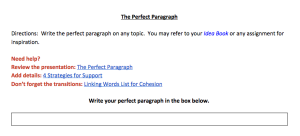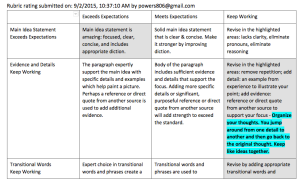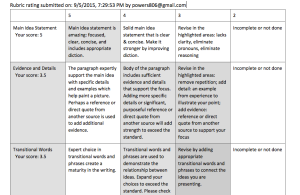It’s almost the end of the first quarter, and I am deep into that never ending cycle: teach, assign, give feedback, reassess. The minute my Google Drive is clear from one assignment, one or two are waiting for feedback. This totally sounds whiney. I know it does. I don’t mean for it be that way, but right now there are two assignments waiting for a first round of feedback and a trickling of a assignments that my students are resubmitting after further revision. So yeah, it’s a little whiney, but I do realize it’s one of the best ways create a real learning environment.
Providing focused feedback and allowing students the opportunity to try again can sometimes lead to something magical: learning… because they want to. That second part is amazing. When I stopped putting a grade on the first draft of a piece of writing, I noticed that my students actually put more effort into revising and editing. The second time I review the assignment I do give them a grade, but they still have an opportunity to revise again. Some do; some don’t. Those who revise again are focused on the improvement. They are learning. AMAZING. Little by little, more and more students go back again.
It gets better.
The next time they write, it’s better the first time around. It doesn’t require as much feedback in certain areas as it did before.
My point is this. Yes, I’m overwhelmed at the beginning of the year. Yes, there are tons of pieces waiting for my feedback. Yes, the kids ask me (daily) if I’ve had a chance to look at their writing — again. But, in the long run, it’s totally worth it.
Don’t forget, focused feedback happens in a variety of ways. Sometimes, I’m walking around while students draft or revise and pointing out some areas to improve. Sometimes students ask me questions while they are drafting, and I provide feedback. Sometimes I use the rubric system I discuss here.
Also, I don’t personally use a feedback only rubric and a numeric rubric on every assignment. When I am focusing on a new writing or literary analysis skill, I do. After students have been working on the same focus for a while, I utilize peer feedback, and then students revise and edit based on their peer’s commentary. Then, I use the numeric rubric. I always allow students to complete further revision one more time as an option. I do not provide class time for the optional revision; students must complete it at home, or they can come use the class laptops early in the morning before school begins. There is also a time limit on the optional revision. Like I said before, some do and some don’t.
Below is a video tutorial related to giving feedback. Obviously, I’m a Google-girl, so I use online tools to give feedback.
This video starts with creating rubrics to use with Doctopus/Goobric. The second half of the video provides a quick review of a complete cycle of feedback: first draft, feedback only, graded feedback, and a resubmission.




Does Goobric work with Google Classroom? This is amazing…
LikeLike
Yes, Sarah. The process is a little different, but it does work with Classroom. Check out the Doctopus Community on G+ for further directions. I can help out with any questions; I’m generally familiar with the interaction with Classroom even though I don’t use it.
LikeLike
Gina,
Your opening…lament is one I totally relate to.
There are two things that helped me to deal with this feeling:
1. The process of giving feedback is the #1 most differentiated/individualized/effective teaching method, so I just kind of repeat that to myself.
2. Giving feedback is a much more enjoyable process than giving traditional grades, because that process feels like beauracratic busy work to me.
Great video demonstration. Those tools are so powerful.
LikeLike
Thanks, Gerard! I know you go through all the same stuff.
LikeLike